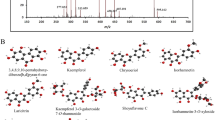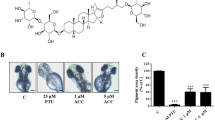Abstract
In this study, the effects of (−)-epigallocatechin-3-gallate (EGCG) and/or hinokitiol (β-thujaplicin) on melanogenesis were investigated. Our results showed that both EGCG and hinokitiol significantly inhibited melanin synthesis in a concentration-dependent manner, and that their hypopigmenting effects were stronger than that of kojic acid, which is known to inhibit melanin formation in melanocytes and melanoma cells. Interestingly, EGCG did not show any additive hypopigmenting effect in combination with kojic acid, though EGCG did show a synergistic effect in combination with hinokitiol. Several reports indicate that the activation of extracellular signal-regulated kinase (ERK) induces microphthalmia-associated transcription factor (MITF) degradation. Accordingly, the effects of EGCG and hinokitiol on the ERK signaling pathway were examined. EGCG and hinokitiol induced neither ERK activation nor MITF degradation. On the other hand, both EGCG and hinokitiol reduced the protein levels of MITF and of tyrosinase, the rate limiting melanogenic enzyme, whereas kojic acid had no effect. In addition, hinokitiol strongly downregulated the activity of tyrosinase, whereas EGCG or kojic acid had only a little effect. These results show that both EGCG and hinokitiol reduce MITF production, and suggest that reduced tyrosinase activity by hinokitiol explains their synergistic effect on melanogenesis.
Similar content being viewed by others
References
Arima, Y., Nakai, Y., Hayakawa, R., and Nishino, T., Antibacterial effect of beta-thujaplicin on staphylococci isolated from atopic dermatitis: relationship between changes in the number of viable bacterial cells and clinical improvement in an eczematous lesion of atopic dermatitis.J. Antimicrob Chemother., 51, 113–122 (2003).
Bentley, N. J., Eisen, T., and Goding, C. R., Melanocyte-specific expression of the human tyrosinase promoter: activation by the microphthalmia gene product and role of the initiator.Mol. Cell Biol., 14, 7996–8006 (1994).
Bertolotto, C., Abbe, P., Hemesath, T. J., Bille, K., Fisher, D. E., Ortonne, J. P., and Ballotti, R., Microphthalmia gene product as a signal transducer in cAMP-induced differentiation of melanocytes.J. Cell Biol., 142, 827–835 (1998a).
Bertolotto, C., Busca, R., Abbe, P., Bille, K., Aberdam, E., Ortonne, J. P., and Ballotti, R., Differentcis-acting elements are involved in the regulation of TRP1 and TRP2 promoter activities by cyclic AMP: pivotal role of M boxes (GTCATGTGCT) and of microphthalmia.Mol. Cell Biol., 18, 694–702 (1998b).
Busca, R. and Ballotti, R., Cyclic AMP a key messenger in the regulation of skin pigmentation.Pigment. Cell Res., 13, 60–69 (2000).
Cowley, S., Paterson, H., Kemp, P., and Marshall, C. J., Activation of MAP kinase kinase is necessary and sufficient for PC12 differentiation and for transformation of NIH 3T3 cells.Cell, 77, 841–852 (1994).
Dooley, T. P., Gadwood, R. C., Kilgore, K., and Thomasco, L. M., Development of anin vitro primary screen for skin depigmenta-tion and antimelanoma agents.Skin Pharmacol, 7, 188–200 (1994).
Englaro, W., Bertolotto, C., Busca, R., Brunet, A., Pages, G., Ortonne, J. P., and Ballotti, R., Inhibition of the mitogen-activated protein kinase pathway triggers B16 melanoma cell differentia-tion.J. Biol. Chem., 273, 9966–9970 (1998).
Hearing, V. J. and Jimenez, M., Analysis of mammalian pigmenta-tion at the molecular level.Pigment. Cell Res., 2, 75–85 (1989).
Hearing, V. J. and Tsukamoto, K., Enzymatic control of pigmenta-tion in mammals.FASEB J., 5, 2902–2909 (1991).
Hemesath, T. J., Price, E. R., Takemoto, C., Badalian, T. and Fisher, D. E., MAP kinase links the transcription factor Microphthalmia to c-Kit signalling in melanocytes.Nature, 391, 298–301 (1998).
Hodgkinson, C. A., Moore, K. J., Nakayama, A., Steingrimsson, E., Copeland, N. G., Jenkins, N. A., and Arnheiter, H., Mutations at the mouse microphthalmia locus are associated with defects in a gene encoding a novel basic-helix-loop-helix-zipper protein.Cell, 74, 395–404 (1993).
Hughes, A. E., Newton, V. E., Liu, X. Z., and Read, A. P., A gene for Waardenburg syndrome type 2 maps close to the human homologue of the microphthalmia gene at chro-mosome 3p12–p14.1.Nat. Genet., 7, 509–512 (1994).
Katiyar, S. K., Afaq, F., Azizuddin, K., and Mukhtar, H., Inhibition of UVB-induced oxidative stress-mediated phosphorylation of mitogen-activated protein kinase signaling pathways in cultured human epidermal keratinocytes by green tea polyphenol (−)-epigallocatechin-3-gallate.Toxicol. Appl. Pharmacol., 176, 110–117 (2001).
Khaled, M., Larribere, L., Bille, K., Aberdam, E., Ortonne, J. P., Ballotti, R., and Bertolotto, C., Glycogen synthase kinase 3beta is activated by cAMP and plays an active role in the regulation of melanogenesis.J. Biol. Chem., 277, 33690–36907 (2002).
Kim, D. S., Hwang, E. S., Lee, J. E., Kim, S. Y., Kwon, S. B., and Park, K. C., Sphingosine-1-phosphate decreases melanin synthesisvia sustained ERK activation and subsequent MITF degradation.J. Cell Sci., 116, 1699–1706 (2003).
Kim, D. S., Kim, S. Y., Chung, J. H., Kim, K. H., Eun, H. C., and Park, K. C., Delayed ERK activation by ceramide reduces melanin synthesis in human melanocytes.Cell Signal., 14, 779–785 (2002).
Kobayashi, T., Urabe, K., Winder, A., Jimenez-Cervantes, C., Imokawa, G., Brewington, T., Solano, F., Garcia-Borron, J. C., and Hearing, V. J., Tyrosinase related protein 1 (TRP1) functions as a DHICA oxidase in melanin biosynthesis.EMBO J., 13, 5818–5825 (1994).
Marshall, C. J., Specificity of receptor tyrosine kinase signaling: transient versus sustained extracellular signal-regulated kinase activation.Cell, 80, 179–185 (1995).
No, J. K., Soung, D. Y., Kim, Y. J., Shim, K. H., Jun, Y. S., Rhee, S. H., Yokozawa, T., and Chung, H. Y., Inhibition of tyrosinase by green tea components.Life Sci., 65, PL241-PL246 (1999).
Oka, M., Nagai, H., Ando, H., Fukunaga, M., Matsumura, M., Araki, K., Ogawa, W., Miki, T., Sakaue, M., Tsukamoto, K., Konishi, H., Kikkawa, U., and Ichihashi, M., Regulation of melano-genesis through phosphatidylinositol 3-kinase-Akt pathway in human G361 melanoma cells.J. Invest Dermatol, 115, 699–703 (2000).
Price, E. R., Horstmann, M. A., Wells, A. G., Weilbaecher, K. N., Takemoto, C. M., Landis, M. W., and Fisher, D. E., alpha-Melanocyte-stimulating hormone signaling regulates ex-pression of micro-phthalmia, a gene deficient in Waarden-burg syndrome.J. Biol. Chem., 273, 33042–33047 (1998).
Sakuma, K., Ogawa, M., Sugibayashi, K., Yamada, K., and Yamamoto, K., Relationship between tyrosinase inhibitory action and oxidation-reduction potential of cosmetic whitening ingredients and phenol derivatives.Arch. Pharm. Res., 22, 335–339 (1999).
Sale, E. M., Atkinson, P. G., and Sale, G. J., Requirement of MAP kinase for differentiation of fibroblasts to adipocytes, for insulin activation of p90 S6 kinase and for insulin or serum stimulation of DNA synthesis.EMBO J., 14, 674–684 (1995).
Steingrimsson, E., Moore, K. J., Lamoreux, M. L., Ferre- D’Amare, A. R., Burley, S. K., Zimring, D. C., Skow, L. C., Hodgkinson, C. A., Arnheiter, H., and Copeland, N. G.etal., Molecular basis of mouse microphthalmia (mi) mutations helps explain their developmental and phenotypic consequences.Nat. Genet., 8, 256–263 (1994).
Tachibana, M., Evidence to suggest that expression of MITF induces melanocyte differentiation and haploinsufficiency of MITF causes Waardenburg syndrome type 2A.Pigment. Cell Res., 10, 25–33 (1997).
Tachibana, M., MITF: a stream flowing for pigment cells.Pigment. Cell Res., 13, 230–40 (2000).
Tassabehji, M., Newton, V. E., and Read, A. P., Waardenburg syndrome type 2 caused by mutations in the human micro-phthalmia (MITF) gene.Nat. Genet., 8, 251–255 (1994).
Tsuboi, T., Kondoh, H., Hiratsuka, J. and Mishima, Y., Enhanced melanogenesis induced by tyrosinase gene-transfer in-creases boron-uptake and killing effect of boron neutron capture therapy for amelanotic melanoma.Pigment. Cell Res., 11, 275–282 (1998).
Wu, M., Hemesath, T. J., Takemoto, C. M., Horstmann, M. A., Wells, A. G., Price, E. R., Fisher, D. Z., and Fisher, D. E., c- Kit triggers dual phosphorylations, which couple activation and degradation of the essential melanocyte factor Mi.Genes Dev., 14, 301–312 (2000).
Xu, W., Gong, L., Haddad, M. M., Bischof, O., Campisi, J., Yeh, E. T., and Medrano, E. E., Regulation of microphthalmia-associated transcription factor MITF protein levels by association with the ubiquitin-conjugating enzyme hUBC9.Exp. Cell Res., 255, 135–143 (2000).
Yasumoto, K., Yokoyama, K., Takahashi, K., Tomita, Y., and Shibahara, S., Functional analysis of microphthalmia-as-sociated transcription factor in pigment cell-specific transcription of the human tyrosinase family genes.J. Biol. Chem., 272, 503–509 (1997).
Yavuzer, U., Keenan, E., Lowings, P., Vachtenheim, J., Currie, G., and Goding, C. R., The Microphthalmia gene product interacts with the retinoblastoma protein in vitro and is a target for deregulation of melanocyte-specific transcription.Oncogene, 10, 123–134 (1995).
Yokoyama, K., Suzuki, H., Yasumoto, K., Tomita, Y., and Shibahara, S., Molecular cloning and functional analysis of a cDNA coding for human DOPAchrome tautomerase/ tyrosinase-related protein-2.Biochim. Biophys. Acta, 1217, 317–321 (1994).
Author information
Authors and Affiliations
Corresponding author
Rights and permissions
About this article
Cite this article
Kim, DS., Park, SH., Kwon, SB. et al. (−)-Epigallocatechin-3-gallate and hinokitiol reduce melanin synthesisvia decreased MITF production. Arch Pharm Res 27, 334–339 (2004). https://doi.org/10.1007/BF02980069
Received:
Issue Date:
DOI: https://doi.org/10.1007/BF02980069




